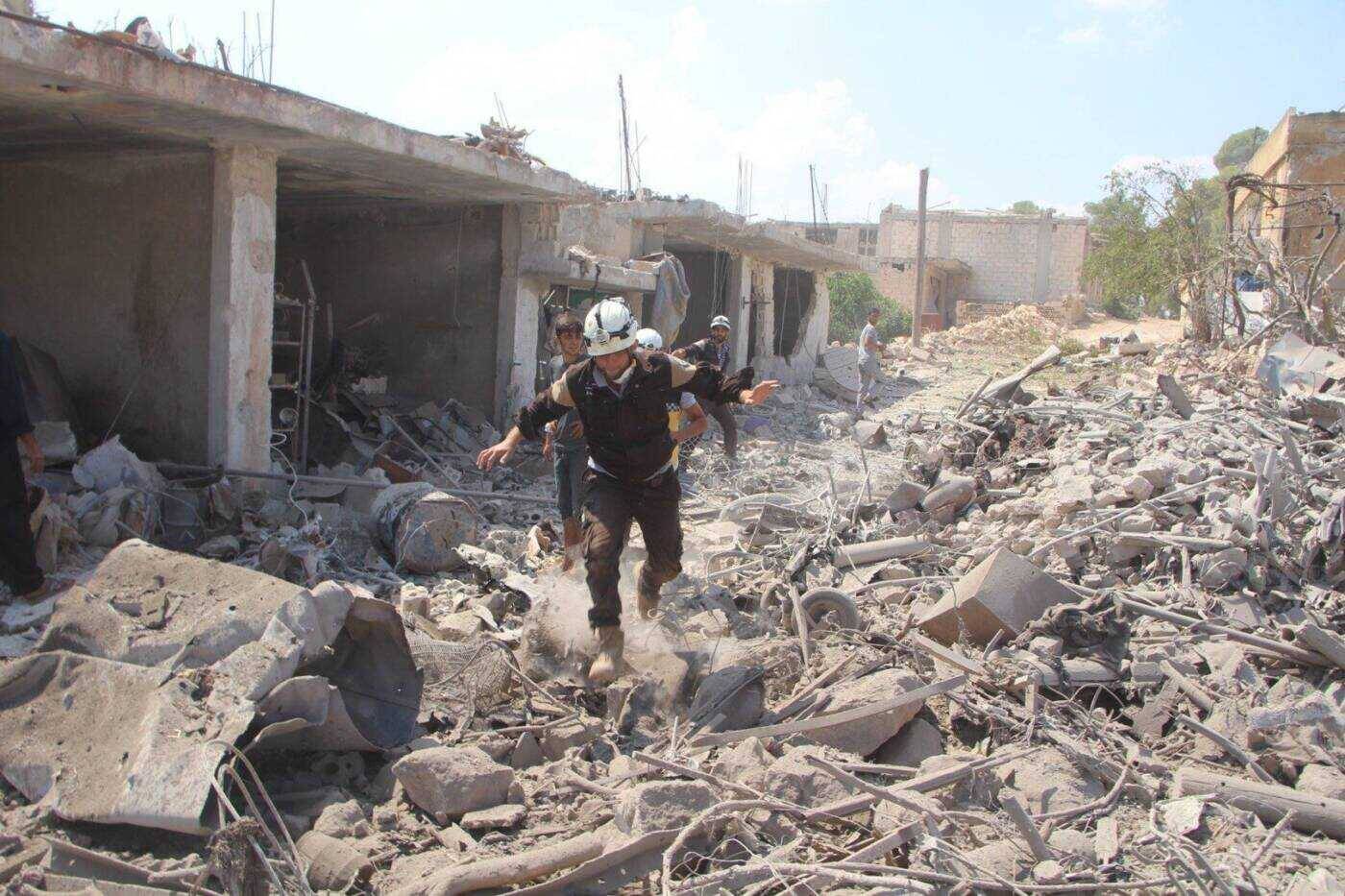‘I don’t know where I can go’: Thousands displaced by bombardment in northwestern Syria
After a government airstrike in al-Hubeit on Sunday. Photo courtesy […]
9 September 2018

AMMAN: Scores of Russian and Syrian airstrikes and artillery barrages pummeled rebel-controlled territory in northwestern Syria on Sunday, killing two children and injuring several others.
Sunday’s bombardment is the latest escalation in northwestern Syria, indicating that the Syrian government and its allies may be preparing to launch an as-yet-unannounced major military campaign against rebels and hardline Islamist groups in the area. Thousands of civilians have already been displaced.
Nearly 50 artillery shells and two helicopter-launched barrel bombs had struck rebel-held territory in Idlib and Hama provinces by Sunday afternoon, Idlib-based Syria Civil Defense spokesman Ahmad a-Sheikho told Syria Direct, adding that airstrikes and artillery shells have killed 24 civilians since bombardment intensified on rebel-held northwestern Syria late last week.
A rocket attack by pro-government forces killed a three-month-old child on Sunday in the southwestern Idlib town of al-Hubeit, according to the Civil Defense.
Rocket attacks and artillery shells injured roughly a half dozen other civilians throughout the day.
Local authorities in al-Hubeit declared the area a “disaster zone” in a statement released via WhatsApp on Sunday, reporting that “hundreds” have fled the town to escape “barbaric” bombings
In videos posted to social media websites by pro-opposition activists on Sunday, a barrel bomb—a term commonly used to describe a type of crude helicopter-launched explosive used by the Syrian government—appeared to strike a target near the rebel-controlled city of a-Latamneh in northern Hama province, some three kilometers away from opposition-government frontlines.
Another bombardment severely damaged a hospital in a-Latamneh on Sunday, leading to its closure, pro-opposition news outlets reported.
Sunday’s bombardment comes as the Syrian government makes preparations for what appears to be the opening movements of a massive campaign against rebels and hardline Islamist groups in Hama and Idlib. The past few weeks have seen the government relocating ground forces and armor towards the outer edges of Syria’s rebel-held northwest, and the Russian military relocating a number of warships to the Mediterranean Sea off the coast of Syria.
Until now, pro-government artillery fire and airstrikes appear to be concentrated on a handful of settlements in northern Hama province and southern Idlib province, close to frontlines between rebel fighters and pro-government forces.
Thousands of civilians in those areas have fled encroaching bombardments, ahead of what many anticipate could become major waves of displacement should the Syrian government move against local rebels.
Fighting in Idlib could “quickly become a humanitarian catastrophe,” the Norwegian Refugee Council warned in a statement last week, predicting that 700,000 people could become displaced in the event of a major pro-government offensive.
Around half of Idlib’s current residents are internally displaced from other regions of Syria.
“The bombing hasn’t stopped—it’s ferocious,” Ibrahim al-Hamawi, a 25-year-old father of one who fled a-Latamneh city on Saturday, tells Syria Direct. “I don’t know where my family and I can go now.”

This is the second time that al-Hamawi, originally from the nearby town of Kafr Zeita, has fled encroaching violence. This time, he relocated with his family to the city of Kafr Nubl, some 30 kilometers northwest of a-Latamneh in Idlib province.
The intense uptick in government aerial bombing sorties and artillery barrages have already displaced as many as 5,000 civilians living in southern Idlib and northern Hama provinces since Saturday, according to the Syrian Observatory for Human Rights.
Although Syrian and Russian warplanes continue to bombard the rebel-held northwest, Damascus-led forces have yet to launch any ground offensive, according to Captain Naji, spokesman for al-Jabha al-Wataniya li-Tahrir, one of two major rebel blocs active in northwestern Syria.
“We have not observed any unusual movements,” Naji told Syria Direct. “But we’re preparing for all possible scenarios.”
Hardline rebel alliance Hay’at Tahrir a-Sham (HTS), led by a former Al-Qaeda affiliate and internationally designated as a terrorist organization, controls major swathes of northwestern Syria. The Syrian government has repeatedly excluded HTS from ceasefire agreements, including a Russia-, Iran- and Turkey-brokered deal identifying four de-escalation zones across the country—including the northwest—last year.
‘The fighting is going to come’
In the Sahel al-Ghab region of northern Hama province, 26-year-old journalist Abdelmajid al-Omar woke Sunday morning to the sound of airplanes.
“We’ve taken two artillery shells so far,” he told Syria Direct. But the last few days’ worth of bombardment has struck nearby areas, far enough away from al-Omar and his family for them to remain in their homes.
Electricity even came on during the day on Sunday—the first time in a week al-Omar and his family have had power.
“Now’s the time to wash your clothes, cook your food and get fat,” al-Omar joked.
But the calm is unlikely to last, he added. His home is a mere two kilometers away from the frontlines, and he worries that the violence in nearby towns will soon reach him.
“The fighting is going to come my way,” he told Syria Direct, adding that, whenever that happens, “of course I’ll need to leave.”
The Syrian government has recaptured a series of major pro-opposition strongholds over the past two years, evacuating rebel fighters, their families and those refusing to remain under government control to the country’s rebel-held northwest. Tens of thousands originally from East Ghouta, South Damascus and Daraa now reside in Idlib province.
Although Damascus has yet to officially announce that any operation to retake control of Idlib and Hama has actually begun, statements by government officials have repeatedly suggested that the fight to retake the province is imminent.
This report is part of Syria Direct’s month-long coverage of internal displacement in Syria in partnership with the Konrad Adenauer Foundation and reporters on the ground in Syria. Read our primer here.








